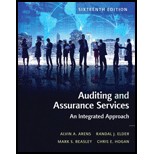
Auditing and Assurance Services (16th Edition)
16th Edition
ISBN: 9780134065823
Author: Alvin A. Arens, Randal J. Elder, Mark S. Beasley, Chris E. Hogan
Publisher: PEARSON
expand_more
expand_more
format_list_bulleted
Concept explainers
Question
Chapter 8, Problem 25.3MCQ
To determine
Identify the correct option for the given statement.
Expert Solution & Answer
Want to see the full answer?
Check out a sample textbook solution
Students have asked these similar questions
ht
=
ences
X
On December 1, Jasmin Ernst organized Ernst Consulting. On December 3, the owner contributed $84,920 in assets to
launch the business. On December 31, the company's records show the following items and amounts.
Cash withdrawals by owner
Consulting revenue
Salaries expense
Cash
$ 8,450
Accounts receivable
16,950
Office supplies
4,080
Rent expense
Land
46,020
Office equipment
18,860
Telephone expense
Accounts payable
9,280
Owner investments
84,920
Miscellaneous expenses
$ 2,930
16,950
4,420
7,900
860
680
Exercise 1-18 (Algo) Preparing an income statement LO P2
Using the above information prepare a December income statement for the business.
ERNST CONSULTING
Income Statement
Revenues
Rent expense
Salaries expense
Telephone expense
Total revenues
$
4,420
7,900
860
$
SA
Assets
Cash
8,450
Accounts receivable
16,950
Office supplies
4,080
Land
46,020
Office equipment
18,860
navable
9,280
13,180
5
11
of 14
Next >
Assets
Current Assets
Cash
Credit card receivables
Accounts receivable
Marketable securities
Food Inventories
Prepaid expenses
Total Current Assets
Golden Bay Balance Sheet as at December 31
Year 2018
Year 2019
$ 18,500
9,807
$ 29,400
11,208
5,983
6,882
15,400
2,000
12,880
14,700
10 800
14 900
73370
79 090
Property Plant & Equipment
Land
Building
Equipment
Furnishings
$ 60,500
828,400
114,900
75,730
(330,100)
16 600
766 030
839 400
$ 60,500
884,400
157,900
81,110
(422,000)
18 300
7 80 210
859 300
Net: Accumulated depreciation
China, glass, silver, & linen
Total Assets
Liabilities & Stockholders' Equity
Current Liabilities
Accounts payable
Accrued expenses payable
Taxes payable
Current mortgage payable
Total Current assets
$ 19,200
4,200
12,400
26 900
62 700
$16,500
5,000
20,900
26 000
68 400
Long-term liabilities
Mortgage payable
Total Liabilities $
$512 800
$486 400
575 500
$555 200
Stockholders' Equity
Common stock ($5 par. 40,000 shares issued & OS) $200,000
Retained earnings…
Mat lives in Barbados and is desirous of starting his own business from inheritances that his parents left him. He approached you for advice on the best type of business to register. Mr. Mat said he would love to gain benefits from any tax relief that is available that the government has to offer. Give advice to Mr. Mat whether it would be more beneficial to start a Company or an Individual Trading Business. outline for Mr. Mat why setting up either a company, or a trading as business is more advantageous over the other. cover matters like: Tax rates, Available tax reliefs and or tax credits Ease of operations of a company, as well as ease of operations of an individual trading business.
Chapter 8 Solutions
Auditing and Assurance Services (16th Edition)
Ch. 8 - Prob. 1RQCh. 8 - Prob. 2RQCh. 8 - Prob. 3RQCh. 8 - Prob. 4RQCh. 8 - Prob. 5RQCh. 8 - Prob. 6RQCh. 8 - Prob. 7RQCh. 8 - Prob. 8RQCh. 8 - Prob. 9RQCh. 8 - Prob. 10RQ
Ch. 8 - Prob. 11RQCh. 8 - Prob. 12RQCh. 8 - Prob. 13RQCh. 8 - Prob. 14RQCh. 8 - Prob. 15RQCh. 8 - Your client, Harper Company, has a contractual...Ch. 8 - Prob. 17RQCh. 8 - Prob. 18RQCh. 8 - Prob. 19RQCh. 8 - Prob. 20RQCh. 8 - Prob. 21RQCh. 8 - Prob. 22RQCh. 8 - Prob. 23RQCh. 8 - Prob. 24RQCh. 8 - Prob. 25.1MCQCh. 8 - Prob. 25.2MCQCh. 8 - Prob. 25.3MCQCh. 8 - Prob. 26.1MCQCh. 8 - Prob. 26.2MCQCh. 8 - Prob. 26.3MCQCh. 8 - Which one of the following statements is correct...Ch. 8 - Prob. 27.2MCQCh. 8 - Prob. 27.3MCQCh. 8 - Prob. 28.1MCQCh. 8 - Prob. 28.2MCQCh. 8 - Prob. 28.3MCQCh. 8 - Prob. 29DQPCh. 8 - Prob. 30DQPCh. 8 - Prob. 31DQPCh. 8 - Your comparison of the gross margin percent for...Ch. 8 - Prob. 33DQPCh. 8 - Prob. 34DQPCh. 8 - Prob. 35DQPCh. 8 - Prob. 36DQPCh. 8 - Prob. 37DQPCh. 8 - Following are statements of earnings and financial...
Knowledge Booster
Learn more about
Need a deep-dive on the concept behind this application? Look no further. Learn more about this topic, accounting and related others by exploring similar questions and additional content below.Similar questions
arrow_back_ios
SEE MORE QUESTIONS
arrow_forward_ios
Recommended textbooks for you
 Auditing: A Risk Based-Approach (MindTap Course L...AccountingISBN:9781337619455Author:Karla M Johnstone, Audrey A. Gramling, Larry E. RittenbergPublisher:Cengage Learning
Auditing: A Risk Based-Approach (MindTap Course L...AccountingISBN:9781337619455Author:Karla M Johnstone, Audrey A. Gramling, Larry E. RittenbergPublisher:Cengage Learning Auditing: A Risk Based-Approach to Conducting a Q...AccountingISBN:9781305080577Author:Karla M Johnstone, Audrey A. Gramling, Larry E. RittenbergPublisher:South-Western College Pub
Auditing: A Risk Based-Approach to Conducting a Q...AccountingISBN:9781305080577Author:Karla M Johnstone, Audrey A. Gramling, Larry E. RittenbergPublisher:South-Western College Pub Accounting Information SystemsAccountingISBN:9781337619202Author:Hall, James A.Publisher:Cengage Learning,
Accounting Information SystemsAccountingISBN:9781337619202Author:Hall, James A.Publisher:Cengage Learning,- Business/Professional Ethics Directors/Executives...AccountingISBN:9781337485913Author:BROOKSPublisher:Cengage

Auditing: A Risk Based-Approach (MindTap Course L...
Accounting
ISBN:9781337619455
Author:Karla M Johnstone, Audrey A. Gramling, Larry E. Rittenberg
Publisher:Cengage Learning

Auditing: A Risk Based-Approach to Conducting a Q...
Accounting
ISBN:9781305080577
Author:Karla M Johnstone, Audrey A. Gramling, Larry E. Rittenberg
Publisher:South-Western College Pub

Accounting Information Systems
Accounting
ISBN:9781337619202
Author:Hall, James A.
Publisher:Cengage Learning,

Business/Professional Ethics Directors/Executives...
Accounting
ISBN:9781337485913
Author:BROOKS
Publisher:Cengage